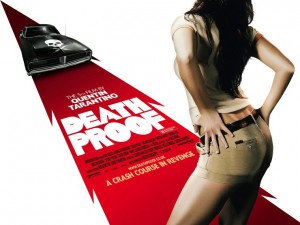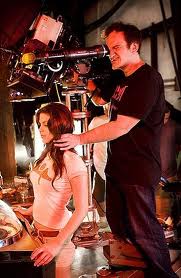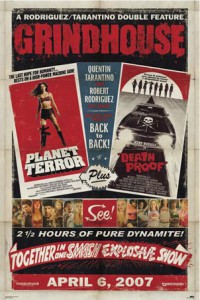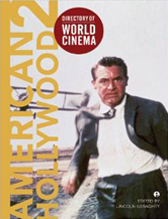
FEATURE: Tarantino Comes of Age
Sixteen years and five films after the release of Reservoir Dogs, Quentin Tarantino is finally beginning to prove that as a filmmaker he’s no mere fly-by-night trend hopper or one-trick pop-culture pony. If anything, with the release of his latest film Death Proof, the man once credited with bringing hyper-violence back into Hollywood, has begun to reveal himself as a maturing director who’s not about to sell-out to the wishes of studio execs or fan expectations.
 It must be said though, that it hasn’t always looked this way for the video store clerk turned auteur extraordinaire. As a critic, I’ve often felt that there are not one, but two Tarantinos. The first is a highly gifted director with an innate cinematic sense for pace and execution; a man for whom celluloid is surely the very lifeblood that courses through his veins. It’s in the second Tarantino, in his guise as screenwriter, that I have occasionally found reason to question his super-prowess. For me, Tarantino’s reference laden, jive-talkin’-hipster-cool dialogue, occasionally wears out its welcome. It’s not that I don’t ‘dig’ his characters – I’ll happily debate the meaning of Madonna songs while chowing down on a ‘Royale with Cheese’ – it’s just that such banter doesn’t always work to the film’s benefit.
It must be said though, that it hasn’t always looked this way for the video store clerk turned auteur extraordinaire. As a critic, I’ve often felt that there are not one, but two Tarantinos. The first is a highly gifted director with an innate cinematic sense for pace and execution; a man for whom celluloid is surely the very lifeblood that courses through his veins. It’s in the second Tarantino, in his guise as screenwriter, that I have occasionally found reason to question his super-prowess. For me, Tarantino’s reference laden, jive-talkin’-hipster-cool dialogue, occasionally wears out its welcome. It’s not that I don’t ‘dig’ his characters – I’ll happily debate the meaning of Madonna songs while chowing down on a ‘Royale with Cheese’ – it’s just that such banter doesn’t always work to the film’s benefit.
Nowhere were these Jekyll & Hyde sides of Tarantino more evident than in the difference between the first and second Kill Bill movies. Where Volume One reached exhilarating heights with its punchy repartee and finely tuned balance of stylised violence, slick choreography, and bloody humour, Volume Two laboured under the weight of burdensome talk, clumsy narrative detours, and an evacuation of the dramatic tension that underlined its predecessor.  If Volume One was the work of Tarantino the director, then Volume Two was surely Tarantino the writer’s.
If Volume One was the work of Tarantino the director, then Volume Two was surely Tarantino the writer’s.
Thankfully in Death Proof the battle of wills between his two personas ultimately comes out in favour of the director, although it must be said not without some struggle. The premise of this film, a homage to the 1970s drive-in flicks, has to do with a scarred stunt man, Mike (Kurt Russell) who hunts down ‘chicks’ with murderous intent in his ‘death proof’ car. On the surface it’s pure exploitation fare. From the moment the gaudy yellow titles flash on screen Death Proof seems awash in a retro show ‘n’ tell style, right down to the dirty print, spliced out frames, celluloid scratches, out of synch sound, and hokey shifts in the soundtrack. It’s formal twitches such as this that have contributed in the past to accusations against Tarantino’s work as shallow and derivative; that his films are simply a pastiche of reworked narratives, characters, and sequences from the cinematic scrap heap.
In Death Proof however, such criticisms would seem to be unjustified. In spite of the emphasis on surface appearances, there is in this film, a distinct self-awareness of the links between history, style, culture and politics, specifically in relation to issues of gender. If the first half of the film serves as a homage to the 1970s era with its overt sexualisation of female characters and sadistic male violence, then the second half, in which Stunt Man Mike meets his match in a group of tougher than expected ‘babes’, is Tarantino’s present-day response.  The doubled structure of the film is clever, in the least as a means of proving that Tarantino is entirely aware of the politics that underlined the 1970s films, values that he is far too clever to simply repeat without a critical conscience.
The doubled structure of the film is clever, in the least as a means of proving that Tarantino is entirely aware of the politics that underlined the 1970s films, values that he is far too clever to simply repeat without a critical conscience.
More than that though, Death Proof shows a continuing interest in assertive female characters, a trait that emerged in earnest in his 1997 film Jackie Brown. Going beyond a mere reversal of traditional gender roles, here Tarantino attempts to show that underneath the bravado of misogynistic violence lurks a pathetic male hysteria. The ending is as deliciously comic as it is a symbolic attempt by Tarantino to move beyond the hyper-masculine posturing that characterised his earlier films, executed with the unstoppable force of a female collective.
 In an era when artistic license and creative control is increasingly shifting from writers and directors, to producers and studio heads, Quentin Tarantino is something of an anachronism within mainstream Hollywood cinema. It’s worth noting then that Death Proof was originally conceived as a shorter companion feature to Robert Rodriguez’s Planet Terror as part of the Grindhouse double that went unreleased in this country. When Grindhouse failed to impress upon the box office in the U.S., Death Proof had an extra 24 minutes added to it so that it could be re-released. I wouldn’t be at all surprised to find that most of that ‘filler’ that originally ended up on the cutting room floor was comprised of writer-Tarantino’s occasional excesses.
In an era when artistic license and creative control is increasingly shifting from writers and directors, to producers and studio heads, Quentin Tarantino is something of an anachronism within mainstream Hollywood cinema. It’s worth noting then that Death Proof was originally conceived as a shorter companion feature to Robert Rodriguez’s Planet Terror as part of the Grindhouse double that went unreleased in this country. When Grindhouse failed to impress upon the box office in the U.S., Death Proof had an extra 24 minutes added to it so that it could be re-released. I wouldn’t be at all surprised to find that most of that ‘filler’ that originally ended up on the cutting room floor was comprised of writer-Tarantino’s occasional excesses.
If that’s the case I’ll happily forgive him his sins and hold out for a DVD release of the films as they were originally intended. As for the reasons why a concept underlined by representations of ass-kicking women failed to garner a broader release or a marketing budget one tenth of the size of conservative dross like Transformers, well, I’ll leave you to ponder that yourself.





RSS feed for comments on this post. TrackBack URI